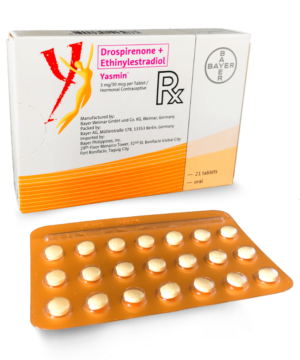Description
XALATAN 5% EYE DROPS 2.5ML
Description :
Each mL contains 50 mcg of latanoprost. One (1) drop contains approximately 1.5 mcg of latanoprost. It also contains the following components: Benzalkonium chloride, sodium chloride, sodium dihydrogen phosphate monohydrate, disodium phosphate anhydrous.
Latanoprost is a prostaglandin F2a analogue. It is isopropyl-(Z)-7[(1R, 2R, 3R, 5S)3, 5-dihydroxy-2-[(3R)-3-hydroxy-5-phenylpentyl]cyclopentyl]-5-heptenoate. Its molecular formula is C26H40O5.
Latanoprost is a colorless to slightly yellow oil which is very soluble in acetonitrile and freely soluble in acetone, ethanol, ethyl acetate, isopropanol, methanol and octanol. It is practically insoluble in water.
Indications / Uses
Reduction of elevated intraocular pressure (IOP) in patients with open-angle glaucoma, chronic angle-closure glaucoma, and ocular hypertension.
Reduction of elevated intraocular pressure in pediatric patients with elevated intraocular pressure and pediatric glaucoma.
Contraindications :
Known hypersensitivity to latanoprost or to any of the components of Xalatan.
Special Precautions :
General: Xalatan contains benzalkonium chloride, which may be absorbed by contact lenses (see Dosage & Administration).
Ocular: Xalatan may gradually increase the brown pigment of the iris. The eye color change is due to increased melanin content in the stromal melanocytes of the iris, rather than to an increase in the number of melanocytes. Typically, the brown pigmentation around the pupil spreads concentrically towards the periphery of the iris and the entire iris or parts of the iris become more brownish. The change in iris color is mild in the majority of cases and may not be detected clinically. The increase in iris pigmentation in one or both eyes has been documented predominantly in patients who have mixed-colored irides that contain the color brown at baseline. Neither nevi nor freckles of the iris have been affected by treatment. No accumulation of pigment in the trabecular meshwork or elsewhere in the anterior chamber has been observed in clinical trials.
In a clinical trial designed to assess iris pigmentation over 5 years, there was no evidence of adverse consequences due to increased pigmentation even when administration of Xalatan continued. These results are consistent with post-marketing clinical experience since 1996. In addition, IOP reduction was similar in patients regardless of the development of increased iris pigmentation. Therefore, treatment with Xalatan can be continued in patients who develop increased iris pigmentation. These patients should be examined regularly and, depending on the clinical situation, treatment may be stopped.
Onset of increased iris pigmentation typically occurs within the 1st year of treatment, rarely during the 2nd or 3rd year, and has not been seen after the 4th year of treatment. The rate of progression of iris pigmentation decreases with time and is stable by 5 years. The effects of increased pigmentation beyond 5 years have not been evaluated. During clinical trials, the increase in brown iris pigment has not been shown to progress further upon discontinuation of treatment, but the resultant color change may be permanent.
Eyelid skin darkening, which may be reversible, has been reported in association with the use of Xalatan.
Xalatan may gradually change eyelashes and vellus hair in the treated eye; these changes include increased length, thickness, pigmentation, and number of lashes or hairs, and misdirected growth of eyelashes. Eyelash changes are reversible upon discontinuation of treatment.
The potential for heterochromia exists for patients receiving unilateral treatment.
Macular edema, including cystoid macular edema, has been reported during treatment with Xalatan. These reports have mainly occurred in aphakic patients, in pseudophakic patients with torn posterior lens capsule, or in patients with known risk factors for macular edema. Caution is recommended when using Xalatan in these patients.
There is limited experience with Xalatan in the treatment of inflammatory neovascular glaucoma. Therefore, it is recommended that Xalatan should be used with caution in these conditions until more experience is obtained.
Xalatan should be used with caution in patients with a history of herpetic keratitis, and should be avoided in cases of active herpes simplex keratitis and in patients with a history of recurrent herpetic keratitis specifically associated with prostaglandin analogues.
Effects on the Ability to Drive or Operate Machinery: Instillation of eye drops may cause transient blurring of vision. Until this has resolved, patients should not drive or use machines.














Reviews
There are no reviews yet.